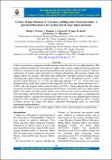| dc.description.abstract | Cashew waste biomass presents a valuable resource for production of value-added products. This
study evaluated potential for valorization of cashew wastes (husks, apples and leaves) generated
in Mtwara, Tanzania through integrating quantitative and laboratory analysis methods. Chemical
composition of cashew waste analyzed were nitrogen, phosphorus, pH, moisture content, total
organic matter, ash content, crude fiber, and conductivity. Nitrogen contents of cashew waste
including husks, apples and leaves ranged between 1.46 – 2.58%, phosphorus was 0.03 – 0.38%,
moisture content between 5.63-23.10%, and pH ranged between 4.44 -5.91. Solid wastes were
characterized by crude fiber content in the range of 0.32-0.49 g, ash content between 6.65 –
14.24% and total organic matter content between 95-97%. Results showed that the annual
generation of cashew wastes was estimated at 458,874 tons. Out of these, 66% were dried cashew
apples, 33% cashew nut shells and 1% cashew husks. These wastes can be transformed into food,
feed, bio-energy and bio-based products using bioconversion technologies in integrated and
sustainable manner. A scheme for utilization of cashew waste into value added products has been
proposed which contributes to environmental preservation. This approach offers a circular
economic growth and aligns with global sustainable development goals by responsible
consumption and production. | en_US |

